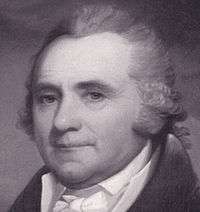Robert Coleman (industrialist)
| Robert Coleman | |
|---|---|
 | |
| Born |
November 4, 1748 County Donegal, Ireland |
| Died |
August 14, 1825 (aged 76) Lancaster, Pennsylvania |
| Occupation | Industrial baron |
| Spouse(s) | Anne Old |
| Children | Edward, James, Anne Caroline, Sarah, William, Thomas Bird |
Robert Coleman (November 4 [O.S. October 23] 1748 - August 14, 1825) was an Irish-American industrialist who rose from a holding clerkship at a prothonotary's office in Philadelphia to bookkeeper at Cornwall Iron Furnace to becoming Pennsylvania's first millionaire.[1]
Iron baron
Coleman was born in County Donegal, and arrived in Philadelphia from Ireland in 1764. After serving as a clerk and bookkeeper he went on to acquire a lease on Salford Forge near Norristown in 1773 and immediately made a sizeable profit by manufacturing cannonballs and shot at Salford and Elizabeth Furnaces. He then used his profits to purchase a two-thirds share of Elizabeth Furnace, shares of Cornwall and the Upper and Lower Hopewell Forges (not the similarly named Hopewell Furnace), and ownership of Speedwell Forge. Soon Coleman was able to construct Colebrook Furnace, purchase the rest of Elizabeth Furnace and acquired 80% ownership of Cornwall Furnace and the ore mines nearby. His business acquisitions and the profits turned from them enabled him to become the first millionaire in the history of Pennsylvania.
Politics
Coleman spent more than three decades as a politician in Pennsylvania. He was a member of the Federalist Party. His career in government began when he attended the Pennsylvania State Constitutional Convention in 1776. Additionally, he served in the Pennsylvania Legislature in 1783, attended the Pennsylvania convention to ratify the United States Constitution in 1787, was chosen as a Presidential elector in both 1792 and 1796, and held the position of Associate Judge from 1791 to 1811. In 1795, Coleman achieved his lone military accomplishment when, as Captain of the Lancaster Troop of Light Horse, he led a company of thirty-five cavalrymen to Western Pennsylvania to assist in the suppression of the Whiskey Rebellion.
Family
Coleman married Anne Old, the daughter of his former employer at Quittapahilla and Speedwell Forges, James Old. Robert and Anne had ten children. His family ultimately settled in Lancaster in 1808. Two of his daughters, Anne Caroline and Sarah, would meet tragic ends while his four sons (William, Edward, Thomas Bird and James) would inherit his estate.
Anne Caroline began dating future United States President James Buchanan in 1818. Buchanan was at the time a lawyer in Lancaster County. They soon became engaged, much to Robert Coleman's displeasure. Coleman was apparently unhappy with Buchanan's reputation and checkered history at Dickinson College in Carlisle, Pennsylvania. Rumors abounded that Buchanan was marrying Anne Caroline for her money, as well as seeing other women. After one incident of him visiting a friend's wife (this may have been an innocent visit), Ann broke off their engagement and died soon afterward, probably from an overdose of laudanum. Some historians theorize this may have been a suicide. James Buchanan was so devastated by the broken engagement and suicide that he vowed never to marry and eventually became the only bachelor President in the history of the United States.
Coleman's other daughter Sarah also committed suicide. She loved William Augustus Muhlenberg who was co-rector of St. James Episcopal Church in Lancaster. Robert Coleman again disapproved of his daughter's relationship. Coleman and Muhlenberg had a bitter dispute about evening worship services. Upon Coleman's death in 1825, Sarah had hoped to be able to finally marry the rector. Coleman's will granted his sons Edward and James the right to approve of Sarah's spouse. Edward also dislike Muhlenberg and would not approve the marriage. Sarah then fled to Philadelphia and committed suicide.
Coleman died in Lancaster at age 76. He was one of the wealthiest and most respected men in Pennsylvania. His legacy was retained through the surviving companies of the Cornwall Iron Furnace company until the industry was replaced by steel manufacturing late in the 19th Century.
References
- ↑ "A Blast From The Past: Cornwall Iron Furnace". Retrieved 2009-12-15.
- "Robert Coleman (1748-1825)". Dickinson College. Retrieved 2007-02-16.